Underground infrastructure is vital for modern cities but traditional excavation methods are slow, expensive, and risky. Advanced non-invasive tools like Ground Penetrating Radar (GPR) and electromagnetic induction streamline underground pipe and cable detection, enhancing safety, reducing construction delays, and minimizing disruptions to urban environments. A meticulous multi-step process involving pre-excavation surveys, RTK GPS technology, visual inspection, and stakeholder communication ensures accurate underground pipe and cable detection.
In today’s world, accurately locating buried utilities is paramount for safe and efficient infrastructure management. With an estimated 90% of all critical services beneath the surface, understanding the challenges of underground infrastructure becomes crucial. This article explores advanced tools designed to enhance precision in underground pipe and cable detection, comparing traditional methods with modern innovations. We delve into key features, best practices, and the impact these advancements have on the industry, ensuring safer, more informed excavation.
Understanding Underground Infrastructure Challenges
Underground infrastructure, comprising pipes, cables, and other essential services, is a complex web hidden beneath our cities and landscapes. Accurately locating these utilities presents several challenges for professionals in construction, engineering, and utility management. Traditional methods often rely on manual excavation, which is time-consuming, costly, and carries inherent risks of damaging buried assets or exposing workers to hazards. The need for advanced detection tools has become increasingly paramount as urban areas expand and infrastructure ages.
Modern solutions focus on non-invasive techniques that utilize technology like ground penetration radar (GPR), electromagnetic induction, and ultrasound to create detailed images of the subsurface. These methods allow for precise identification and mapping of underground pipes and cables without disturbing the surface or disrupting existing services. This shift towards advanced tools promises more efficient project planning, reduced construction delays, and enhanced safety in what is often referred to as a labyrinthine underground world.
Traditional vs Advanced Detection Methods
In the realm of locating buried utilities, traditional methods have long relied on manual excavation and visual inspection, a time-consuming and labor-intensive process prone to errors. These conventional techniques often involve digging up large areas to identify underground pipes and cables, leading to disruptions, delays, and potential damage to surrounding structures.
Advanced detection methods, however, have emerged as game-changers in this field. Utilizing cutting-edge technology like ground-penetrating radar (GPR) and electromagnetic location systems, professionals can now pinpoint the exact positions of underground pipes and cables with remarkable precision. These advanced tools offer a non-invasive approach, enabling quick surveys without causing disturbances to the surface or existing infrastructure. As a result, they significantly enhance efficiency, reduce costs, and mitigate risks associated with traditional excavation methods in underground pipe and cable detection.
Key Features of Modern Underground Pipe and Cable Detection Tools
Modern underground pipe and cable detection tools are revolutionizing the way utility location is conducted, offering unprecedented precision and efficiency. These advanced technologies employ a combination of sophisticated sensors, electromagnetic fields, and radar signals to accurately map out buried structures beneath the earth’s surface. Key features include real-time data visualization, allowing professionals to identify pipes and cables with remarkable clarity; high-resolution imaging capabilities that can distinguish between different material types; and ergonomic designs that enhance operator comfort during extended use.
Additionally, these tools are equipped with advanced software platforms that integrate data from multiple sensors, providing a comprehensive and unified picture of the underground environment. This not only streamlines the location process but also significantly reduces the risk of damage to critical infrastructure during excavation projects. The ability to pinpoint utility positions precisely, down to the centimeter, is a game-changer in industries such as construction, utilities maintenance, and civil engineering, ensuring safer and more efficient operations.
Best Practices for Accurate Utility Location
Accurate utility location is paramount in avoiding damage during excavation projects. Best practices involve a multi-step approach that combines advanced tools with meticulous planning and execution. Begin by conducting thorough pre-excavation surveys using ground-penetrating radar (GPR) or electromagnetic (EM) locators to map the approximate positions of underground pipes and cables. These non-invasive technologies can detect various utilities, including water, gas, electricity, and telecommunications lines, without disturbing the soil.
Next, integrate real-time kinematic (RTK) GPS technology for precise positioning during excavation. RTK GPS systems provide centimeter-level accuracy, ensuring that location data is both detailed and reliable. Combine this with visual inspection and manual locating methods, where trained professionals use probes, pressure flushers, or water jets to identify utility lines at the surface. Regular communication among project stakeholders, including utility companies and excavators, is crucial to verify and cross-reference data for comprehensive coverage and ultimate accuracy in underground pipe and cable detection.
Advanced tools for locating buried utilities with precision are transforming the industry. By adopting modern techniques and technologies, such as ground-penetrating radar, electromagnetic induction, and real-time location systems, professionals can navigate complex underground landscapes more effectively. These innovative tools not only enhance safety but also streamline project timelines and reduce damage risks associated with traditional methods. Implementing best practices, including thorough planning, regular calibration, and continuous training, ensures accurate utility location, ultimately contributing to efficient infrastructure management.
